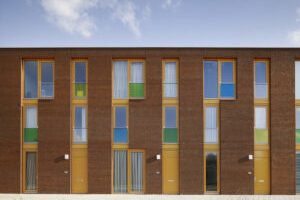



Groningen, Netherlands
Main objectives of the project
The 'Super-Shell' housing system offers maximum freedom for personalization. The houses are sold empty, providing only the structure and facades, allowing users to choose the position of installations within the house. This strategy empowers users to become the architects of their own homes, increasing personalization possibilities. The system offers seven different layouts printed on transparent paper, allowing users to combine and choose the most suitable configuration for their lifestyle. A catalog of facade types is also provided to enhance personalization based on light, views, and open-air spaces. The exterior personalization reflects the contrast between individual and collective identity, while avoiding the uniformity of the first modernity housing system. Additionally, a nine-story tower with flexible housing typology, including apartments for people with disabilities, was added to the project, along with new public spaces.
Date
- 2012: Rehabilitación
Stakeholders
- Architect: Casanova+Hernández architects
Location
City: Groningen
Country/Region: Groningen, Netherlands
Description
The ‘Super-Shell’ houses system provides the user maximum level of freedom to personalize his house. The house is sold completely empty, offering only the structure and the facades, without any installations or rooms inside. Three strategically holes located in the floors allow the user to choose the position of the installations within the house after bying it. In this project several strategies have been applied to allow the personalization of the houses:
By choosing this strategy, the house is thought and designed by the user under certain frame conditions. The user becomes the architect of his house in the same way he is becoming nowadays the architect of his own life.
The possibility of placing kitchen, toilets and bathrooms in very different positions, combined with the flexibility of choosing the position for the rest of the rooms, increases enormously the number of possible layouts of the house and its level of personalization.
Another strategy tested in this project to offer a wide range of possibilities to personalize the houses, has been to provide seven different layouts of ground floors, first floors and second ones printed on transparent paper. The user has been able to combine the transparent papers to decide which layout suits better his way of living.
In total 343 layouts are possible with this system.
A catalogue of different façade types has also been provided to personalize further the house in order to satisfy the interior necessities of light, views and possible open air spaces.
On the one hand the personalization of the exterior of the house reinforces the contrast between individual and collective identity and reflects the social conflict between individualization and society. On the other hand the personalization of the house avoids the typical result of the housing system of the first modernity according to which every family had the same identical dwelling with the same appearance.
The nine-storey tower added during the development process, contains 16 apartments for people with disabilities +25 apartments, with a super-flexible housing typology and with some new public spaces.
